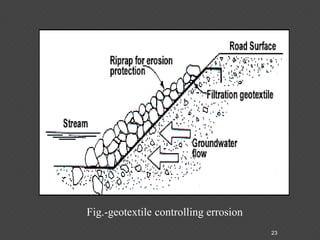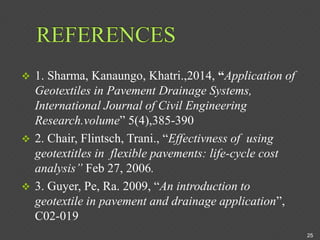The effects of three flexible pavement design parameters were evaluated. Design the pavement with the same traffic and subgrade condition using the selected emulsified base.
And their impact on the results was investigated.

. Geotextile filter must allow water or gas to pass without GEOTEXTILES IN GENERAL Geotextile Functions and Applications Filtration 24 geotextile filter must allow water or gas to pass without significant buildup of hydrostatic pressure. The average is 26. Uses of Geotextile in Construction.
Topics For Seminar March 13 2014. Specifically geosynthetics have been used for separation Zornberg JG. In contrast a geomembrane is a continuous membrane-type liner or barrier Geomembranes must.
A geotextile may be made of synthetic or natural fibers. The primary design consideration for such geotextile are construction survivability and soil retention. The study concludes that the cost effectiveness ratio from the two design methods shows that the lowest cost-effectiveness ratio using Al-Qadis design method is 17 and the highest is 32.
A layer of non-woven geotextile is impregnated in between existing and new asphalt layers. The scope of geotextile in the engineering field is very vast. A geotextile-lined drainage trench along the edge of a road pavement is an example using a geotextile as a.
Geotextile apparent opening size is related by a factor of 12 to 1 with d85 size of the soil being retained. Advances in the Use of Geosynthetic in Pavement Design. Geotextile construction damage decreases exponentially with an increase in mass per unit area.
Function in pavements. While the M-E Pavement Design Guides MEPDG have been officially adopted eg Australia 2004 and AASHTO 2008 these guides do not include the evaluation of pavement performance when. 2332 The strip methodis primarily used on Portland cement concrete PCC pavements and involves preparing the existing cracks and joints and placing a 12 to 24 inch wide geotextile and sufficient asphalt directly on the cracks and joints.
GEOSYNThETiCS iN PAvEmENT dESiGN Geosynthetics have been used in pavement design to address the functions of separation filtration lateral drainage sealing and reinforcement. A major initiative in pavement design was the development and implementation of the Mechanistic-Empirical M-E methods. Out of this consider 2-in as surface course and the remaining as base course.
The geotextile absorbs asphalt to become a waterproofing membrane minimising vertical flow of water into the pavement structure. Compute the thickness of emulsified base by taking the surface course thickness as 2-in. 52 JUTE FIBRES Use of Jute Geotextiles for Improving Performance of PMGSYRoads To study the use of jute geotextile in the road pavement Benefit of JGT of varying strength as an agent for improvement in load bearing capacity of the subgrade specifically the subgrade CBR and overall improvement in pavementperformance Role of open weave JGT as bio-engineering.
A geotextile is defined as any permeable textile material that is used with foundation soil rock earth etc to increase stability and decrease wind and water erosion. Design full depth HMA for the traffic and subgrade condition. Materials in pavement design.

Geotextiles In Transportation Applications Ppt Video Online Download







0 comments
Post a Comment